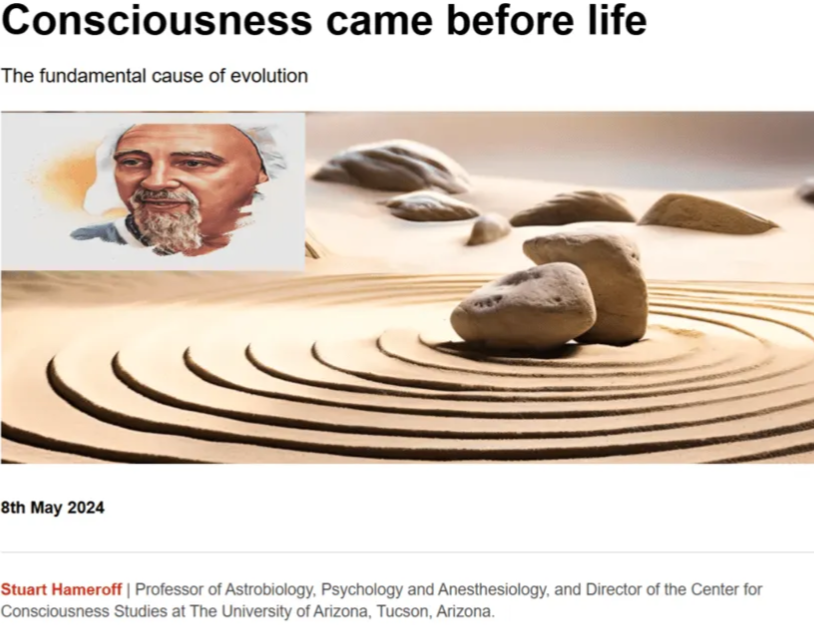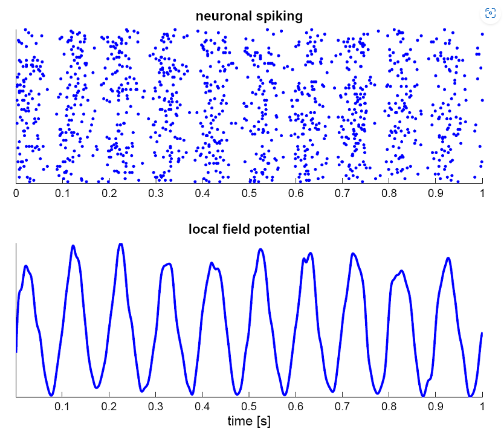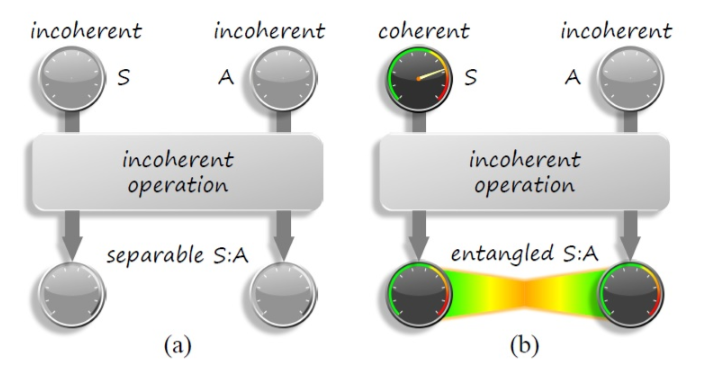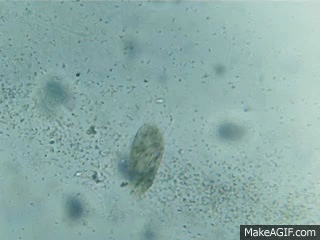I’ve often been criticised for bringing up the religious/spiritual views and motivations of idealist philosophers. (“Why don’t you concentrate on their arguments and evidence instead?” I do.) This is very odd because many idealists frequently bring such things up themselves. Indeed, the passages quoted below — from Stuart Hameroff himself — make that crystal clear. These religious/spiritual additions to the science are either relevant or they’re irrelevant. So if they’re irrelevant, then why does Hameroff himself frequently bring them up? Indeed, why does he tie them directly and strongly to his scientific work?

[See my ‘Did Consciousness Come Before Life?’.]
(i) Introduction
(ii) Jim Al-Khalili on Quantum Biology
(iii) Quantum Mechanics and “Signs of Life”
(iv) Quantum Coherent Oscillations
(v) Quantum Optical Superposition Effects and Triplets-of-Triplets
(vi) Stuart Hameroff’s Anaesthesiology
(vii) Stuart Hameroff’s Ancient Primordial Soup
(viii) Primordial Pleasure-Seeking
(ix) Stuart Hameroff on Paramecium
The words “universal consciousness” are used in the title above because they perfectly sum up Stuart Hameroff’s actual scientific and philosophical position. More relevantly, Hameroff himself sees things in terms of universal consciousness. [See here.]
In detail. Hameroff’s consciousness-before-life-and-evolution thesis squares perfectly with Deepak Chopra’s “spiritual” position on universal consciousness. [See here.] This isn’t my own biased interpretation: it’s Hameroff’s own position.
For example, in an article called ‘‘Darwin Versus Deepak’: Which Came First, Feelings, or the Brain?’, Hameroff writes:
“In a recent exchange in the Washington Post ‘Answer Sheet’ blog, Steven Newton rudely mocks Deepak Chopra’s view that ‘consciousness drives evolution’, a view that would entail consciousness existing in some way intrinsic to the universe, and outside biology. As strange as Deepak’s assertion may appear to some, I believe it is likely to be scientifically correct.”
He then concludes:
“So I think Deepak is correct. Consciousness drives evolution.”
Hameroff also wrote the following words:
“I think more like a quantum Buddhist in that there is a universal proto-conscious mind which we can access, and can influence us.”
And elsewhere:
“I would define spirituality along three lines [] an interconnectedness among living beings and the universe; the ability to influence or access Platonic cosmic wisdom embedded in the universe, divine guidance, the way of the Tao; and the possibility of conscious existence outside of the body after death, even reincarnation.”
Hameroff has also compared the “universal proto-conscious mind” to Brahman of Indian philosophy. [See here.]
But what about the science?
The following words are a quick introduction to that:
“The Orch OR proposal suggests conscious experience is intrinsically connected to the fine-scale structure of space–time geometry, and that consciousness could be deeply related to the operation of the laws of the universe.”
The obvious question now is the following:
Why use the word “consciousness” at all about something at the level of “the fine-scale structure of space–time geometry”?
Sure, in certain Eastern religions, this may make sense. However, outside that tradition, it’s an extremely odd use of the word “consciousness”.
[One may wonder if the Latinate word “consciousness” is a good or accurate translation of the word/s found in Eastern religion.]
Jim Al-Khalili on Quantum Biology

It must now be noted that there’s no denial of the link between biology and quantum phenomena in this essay. Unlike a few decades ago, it’s now fairly well established (although there are still some controversies) that quantum phenomena are important in biological systems.
So let me quote the theoretical physicist Jim Al-Khalili here:
“Quantum biology, as we define it today, means exploring the mechanisms and phenomena that rely on non-trivial quantum effects within living cells. By non-trivial I mean quantum tunnelling, long lived quantum coherence and superposition, quantum entanglement. These are surprising effects that we are now seeing taking place within living organisms. That is quantum biology.”
Al-Khalili then makes it all the more concrete by providing examples of quantum phenomena in biological systems:
“[W]hether it’s in enzyme catalysis,[16] [17] [18], whether it’s in mutations of DNA,[19] [24] even more controversially the way we smell, the theories of olfaction,[25] or magnetoreception, the way certain animals can sense the Earth’s magnetic field, the chemical compass that allows them to detect the orientation of the field.”
Al-Khalili also mentions Hameroff’s own microtubular theory of consciousness:
“The idea is that there were these proteins within the neurons of the brain that could exist in a quantum superposition of two configurations and when enough of them became entangled together that’s when consciousness switched on.”
More interestingly, Al-Khalili then picks up on something that’s very relevant to this essay. He writes:
“Quantum biology was seen as an outside, rather controversial, somehow wacky area of science. Particularly when you think about some of the ideas that grew up during the late 1960s, late 1970s, when people were using quantum mechanics to describe all sorts of strange phenomena such as telepathy or ideas in pseudo-science. Quantum mechanics developed this mystical arm.”
… And that tradition of “mystical” (ab)uses of quantum mechanics can now be found in the current work of Stuart Hameroff.
Quantum Mechanics and “Signs of Life”

The following passage is a dose of (to use a popular phrase) “the science behind” Hameroff’s spiritual philosophy:
“[S]ome ‘signs of life’ are pre-conditions for OR and could be detected, e.g. coherent oscillations, quantum optical superposition effects and triplets-of-triplets. If we find such signs of life in a sample, we will expose them to anesthetic gas to see if they are inhibited proportional to anesthetic potency in blocking consciousness in animals and humans.”
So, firstly, we need to define (or explain) the words “signs of life”. Or, more accurately, we need to know what exactly Hameroff means by “signs of life”.
Of course, Hameroff uses the word “signs” in the phrase “signs of life”. This must mean that, here at least, he isn’t saying that “coherent oscillations, quantum optical superposition effects and triplets-of-triplets” actually constitute life or consciousness. Instead, he’s saying that they’re signs of life and consciousness.
But what does that mean?
Well, in Hameroff’s biological microtubular theory, such quantum phenomena are strongly connected to consciousness. (They’re so connected in human or animal brains.) However, in the context above, Hameroff is talking about coherent oscillations, quantum optical superposition effects and triplets-of-triplets as they occurred before life and evolution — before biology.
Quantum Coherent Oscillations

Whichever definition we accept, it’s clear that “coherent oscillations” alone can’t be “signs of life”. In other words, the coherent oscillations of quantum phenomena in and of themselves can’t constitute such signs. Indeed, these are quantum phenomena which aren’t usually associated with either consciousness or biology…
Sure, that doesn’t mean that coherent oscillations can’t be associated with consciousness and biology.
More relevantly, coherent oscillations play an important part in Hameroff’s microtubules-based theory of consciousness.
Interestingly, Francis Crick and Christof Koch put forward the view (in their 1990 paper ‘Towards a Neurobiological Theory of Consciousness’) that coherent oscillations may be the basis of consciousness. They wrote:
“[I]n neural terms [,] binding means the temporarily correlated firing of the neurons involved. In other words, neurons in different parts of [the] cortex responding to the currently perceived object fire action potentials at about the same time. [ ] that an important mechanism may involve neurons firing in semisynchrony at a frequency in the 40–70 Hz range [ ].”
As far as can be seen, Crick and Koch didn’t refer to quantum coherent oscillations. Instead, they simply focused on neurons and their coherent oscillations.
In any case, the coherent oscillations discussed directly above occur in biological brains. But, of course, coherent oscillations occur outside of animal brains too. And it is that fact that Hameroff latches onto.
Quantum Optical Superposition Effects and Triplets-of-Triplets

Everything just said about quantum coherent oscillations can also be said about “quantum optical superposition effects”. (Quantum optical superposition effects occur in the study of the quantum-mechanical properties of light.) Again, on their own, such things don’t constitute either signs of life or signs of consciousness…
Such quantum effects do play a role in Hameroff’s biological (microtubule-based) theory of consciousness. However, in the quote above, Hameroff is talking about quantum optical superposition effects as they occurred completely apart from biology, and therefore before life and evolution.
“Triplets-of-triplets”? Ditto.
Is Hameroff at all justified in claiming that coherent oscillations, quantum optical superposition effects and triplets-of-triplets can be directly tied to either signs of life or signs of consciousness as they occurred before life and evolution?
Stuart Hameroff’s Anaesthesiology

Stuart Hameroff is an anesthesiologist.
So, as an anesthesiologist, he told us that if he “find[s] such signs of life in a sample”, then he’ll
“expose them to anesthetic gas to see if they are inhibited proportional to anesthetic potency in blocking consciousness in animals and humans”.
This means that Hameroff is applying a technique and a theory which have hitherto been used to study the brains of “animals and humans”, and then applied them to quantum phenomena as they occur in complete separation of biological brains.
So, initially at least, it may seem odd that Hameroff is exposing biology-free quantum phenomena to an anesthetic gas. However, he’s doing this to see if “they are inhibited” by this procedure. In other words, because anesthetic gas inhibits “potency” in animals and humans, then perhaps it will do exactly the same thing (or at least do a similar thing) to biology-free quantum phenomena.
As a layperson, I would guess that anesthetic gas would affect the coherent oscillations, quantum optical superposition effects and triplets-of-triplets as such things can be found in biology-free quantum states and conditions. However, surely that isn’t also to connect such quantum phenomena to signs of life and consciousness.
Stuart Hameroff’s Ancient Primordial Soup

Hameroff was at his most speculative when he stated the following words:
“The ‘Origin of life’ in the primordial soup. Organic molecules coalesce with non-polar quantum interiors enabling conscious events [ ].”
Actually, Hameroff moves beyond mere speculation (or talk about what possibly might have been the case) in the above by tacitly stating that “conscious events” did occur. That is, the “primordial” state of affairs outlined above “enabl[ed] conscious events”.
Then, in the following passage, Hameroff tells us more about what he calls the “ancient primordial soup”:
“In the ancient primordial soup, amphipathic molecules are thought to have formed soap molecule-like ‘micelles,’ which envelope the insoluble, oil-like aromatic rings. These micelles were theorized by Alexander Oparin to have become biological ‘proto-cells,’ developed behaviors for survival, and then become cells and organisms.”
Most readers of this essay won’t be biochemists or quantum physicists. So we need to define some terms here.
Firstly, talk of “amphipathic molecules” [see here] is talk of biochemistry. More broadly, Hameroff is talking about water-based biomolecules. (A biomolecule is a chemical compound which is found in living organisms.)
In any case, it’s hard to provide a simple explanation of all Hameroff’s highly-technical biochemistry. However, the following is the relevant passage:
“These micelles were theorized by Alexander Oparin to have become biological ‘proto-cells,’ developed behaviors for survival, and then become cells and organisms.”
The important words above are “behaviors for survival”. In basic terms, then, Hameroff connects these behaviors for survival to consciousness. That is, he can’t see how there could have been such behaviors if these “biological ‘proto-cells” didn’t somehow instantiate consciousness — at least to some degree.
Hameroff then asks these questions:
“But why would this have happened, long before genes and brains? What would motivate simple creatures’ purposeful behavior to survive?”
It’s clear that Hameroff believes that these cells instantiated consciousness because he then tells us that
“[e]volution may have worked to optimize, organize, and prioritize more advanced conscious experience”.
So we now have “advanced conscious experience”. However, firstly we had less-advanced conscious experience. Hameroff, of course, focusses on the latter.
Hameroff then moves on from “pure” consciousness (or “conscious events”) to what he calls “pleasure-seeking”.
Primordial Pleasure-Seeking

The notion of “conscious feelings” is central to Hameroff’s general theory.
For example, Hameroff tells us that “[c]onscious feelings drive behavior which serves evolution”. He adds:
“[P]rimitive conscious feelings, e.g. pleasure, could have been the ‘spark of life’, a fitness function toward which life formed and evolved to optimize pleasure, to ‘feel good’.”
Hameroff also offers his readers some more detail:
“[H]umans and animals appear to be driven by conscious feelings (e.g. ‘Epicurean delight’, Freud’s ‘pleasure principle’, ‘dopaminergic reward’).”
Hameroff ties all this to the chemical situation as it was before life and evolution.
According to Hameroff, we have less-advanced forms of “pleasure-seeking”. More clearly, he believes that less-advanced forms of consciousness (as found in proto-cells) led to “more advanced forms of pleasure-seeking”.
So Hameroff’s argument is that if there were less-advanced forms of consciousness, then surely there must also have been less-advanced forms of pleasure-seeking.
But if there wasn’t consciousness in the first place, then there couldn’t have been any form of pleasure-seeking either…
Unless, that is, Hameroff is using the words “consciousness” and “pleasure-seeking” in an extremely loose and broad way. (Perhaps he’s using these terms poetically or metaphorically.)
Hameroff uses the words “pleasure” and “displeasure” in the following passage too:
“Some of these would exhibit positive reinforcement, a primitive form of pleasure. Thus, this mechanism could have served as a feedback fitness function for aromatic rings on amphipathic molecules to arrange within micelles for OR events which increase pleasure and avoid displeasure. Thus, the origin of life may have been prompted and driven by conscious feelings right from the start.”
In the passage above we have (possibly) acceptable and very-technical science being fused with speculations, as well as with poeticisms and metaphors.
Now let’s move a little beyond the primordial soup and tackle Hameroff’s position on paramecium.
Stuart Hameroff on Paramecium

In the following passage, Hameroff plays down neurons at the same time as he still tacitly plays up biology:
“[E]quating neurons with ‘bits’ is an insult to neurons. Single cell organisms like paramecium swim about nimbly, find food and mates, avoid obstacles and predators, learn and remember [ ] and have sex with a partner [ ]. They do so using hair-like sensors and motorized oars called cilia, comprised of protein polymers called microtubules (identical to those within brain neurons).”
So this passage, at least as taken on its own, doesn’t really advance Hameroff’s consciousness-before-life-and-evolution thesis. What’s more, Hameroff admits that “[n]obody knows whether paramecium is conscious”. And neither does the mathematical physicist Roger Penrose (Hameroff’s collaborator), who wrote an almost identical passage here:
“If we are to believe that neurons are the only things that control the sophisticated actions of animals, then the humble paramecium presents us with a profound problem.”
So what is the nature of that problem?
Penrose continues:
“For she [a paramecium] swims about her pod with her numerous tiny hairlike legs — the cilia — darting in the direction of bacterial food which she senses using a variety of mechanisms, or retreating at the prospect of danger, ready to swim off in another direction. She can also negotiate obstructions by swimming around them. Moreover, she can apparently even learn from her past experiences [].”
“How is all this achieved by an animal without a single neuron or synapse? Indeed, being but a single cell, and not being a neuron herself, she has no place to accommodate such accessories. [ ]
“The question is significantly raised, of course, as to whether a paramecium — or, indeed, an individual human liver cell — might actually possess some rudimentary form of consciousness [].”
Penrose then goes on to partially answer his own question when he sceptically states the following:
“[I]t must also be the case that the detailed neural organization of the brain is fundamentally involved in governing what form that consciousness must take. Moreover, if that organization were not important, then our livers would evoke as much consciousness as do our brains.”
In that passage, then, Penrose stresses “the detailed neural organization of the brain” (i.e., biological complexity). So this certainly doesn’t help Hameroff’s consciousness-before-life-and-evolution thesis either.
The obvious question now follows:
If “nobody knows whether paramecium is conscious”, then how does Hameroff know that “conscious events” occurred long before life and evolution?







No comments:
Post a Comment